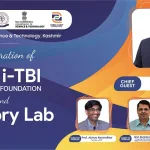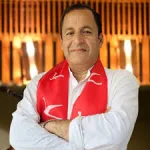BEYOND RITUALS
Herath (Maha Shivratari) in Kashmiri, is derived from the Sanskrit word “Hara Ratri” or the “Night of Hara” (another name of Shiva). There is an interesting story surrounding the snowfall on Herath (Maha Shivaratri) during the rule of Afghan governor Jabbar Khan in the 18th century that adds an intriguing layer to the cultural and religious significance of this festival in Kashmir.
During Jabbar Khan’s reign, the tradition of celebrating Maha Shivaratri was disrupted as he compelled Kashmiri Pandits to observe the festival in July instead of its traditional date. This act was likely intended as a means of asserting control and challenging local customs and beliefs and also attempting to manipulate religious practices for his own purposes.
The story takes an unexpected turn when, despite the unusual timing of the festival, snowfall occurs on the day of the celebration. This event narrated to us by our ancestors has been interpreted as a divine response to Jabbar Khan’s scepticism and bad motives. The snowfall on Maha Shivaratri serves as a miraculous occurrence, validating the faith and devotion of the Kashmiri Pandits and reaffirming the significance of the festival in its traditional form. It became a symbolic moment of divine intervention, highlighting the resilience of religious traditions in the face of external pressures and attempts at coercion.
However, there is another part of the same story and that led to the incorporation of word “Salaam” into the festival of Herath (Maha Shivaratri). It is further narrated that as a gesture of reverence and acknowledgment of the divine power witnessed during the snowfall (Hayrath: Astonishment) the local Muslims started paying visit to Kashmiri Pandit houses to greet them the next day. While this Salaam Namaste has been going for many centuries, given it had left an enduring impact on the collective consciousness and cultural identity of the Kashmiri people, until the new breed of Jabbars intruded in Kashmir and not only hounded the pandits out but also wounded the collective consciousness of the culturally rich society.
Back to Herath, this story adds depth to the narrative surrounding Herath in Kashmir, emphasizing the festival’s rich and deeper cultural, religious, and historical dimensions, as well as its enduring significance in the face of adversity. To many people in the community, Herath means many different things. At a very mundane level, for many it symbolizes the marriage of Shiva and Shakti, for some it is a ritual of Vatuk Barun that is rooted in the tantra tradition and perhaps for some it is an opportune moment for spiritual transformation. The Nilamata Purana says, ‘The Shiva Ratri is observed on the dark 14th of Phalguna. However, Herath is primarily focused on the worship of Bhairava rather than the marriage of Shiva and Parvati.
Bhairava, a fierce manifestation of Lord Shiva, embodies protective energies and symbolizes the destruction of negative forces. The rituals and practices during Herath are centered around invoking Bhairava’s presence who is worshipped during the Herath festival in the form of Vatuk.
Literally, Vatuk means a school going child, but the grammarians have analysed it as: “He who winds up, twists around causes to shrink up, and encloses or encircles, is revered as Vatuka”. Vatuk represents the childlike aspect of Bhairava, symbolizing innocence, purity, and divine energy. Perhaps Vatuk is and has remained an important part of the Kashmiri Pandit psyche that has been followed for millennials. Various earthen vessels, made by the Kral (potter) are used as part of the Vatuk Pooja. These vessels symbolize different aspects of the deity and are arranged in a specific manner during the pooja. The arrangement of these vessels holds symbolic significance and represents the presence and blessings of Vatuk Bhairava during the worship ceremony.
From what we have witnessed during our childhood in Kashmir and many of our elders and scholars, Herath actually used to start from Hure Ogdoh( falgunpratipadha). Hure Ogdoh refers to the first day of the month of Phalguna in the Kashmiri calendar, which corresponds to Falgun Pratipada in the Hindu lunar calendar. This day used to mark the beginning of the 13-day-long celebration of Herath (Maha Shivaratri). On Hure Ogdoh, preparations for the Herath festival typically commenced, including cleaning homes, especially Thokur kuth (pooka room), Choka ( kitchen) and Kanee ( top floor in the house) and then gathering materials for the pooja, and making arrangements for the upcoming rituals and ceremonies.
It served as the starting point for the festivities, leading up to the main day of Herath on the 13th day of the month. During these days Kashmiri Pandit families will perform different sets of pooja at their homes. The common belief that excited every Kashmiri family for these preparations was that during these days Lord Shiva is in the form of Prachand Bairav and Ma Parvati is the Bhairavi. There coming together brings in Rudragan, Vatak Bhairav, Raman Bhairav and other Ganas, Ganesha, Kartikeya. So, like a good host, during first seven days, every family will prepare by cleaning their house, clearing and setting utensils in order, preparing for the special kind of spices and mishthans. From the seventh to ninth day, Kashmiri Pandits used to offer prayers to the presiding deity of the valley – goddess Sharika. On 9th day, the local potter” Kral, who made the Vatuk will bring it to the Kashmiri Pandits house. As soon as the potter entered the house gates, the family elder ladies will welcome him and Vatuk material with Aalath( diya/flower thali).
The tenth day is the day of Lakshmi, and there was a tradition where every family sends a felicitation card to their mother-in-law. After receiving Vatuk material, the house ladies will go to their parental home inviting their mothers and will return on 10th days along with some Atgath (a shagun money given). On 11thDay, of Gada Kah, families offered prayers, rituals, and offerings to their chosen Bhairava, expressing gratitude for protection and seeking blessings for continued well-being. This tradition reflects the close connection between Kashmiri Pandits and their local deities, as well as the importance of community bonds and spiritual practices in Kashmiri culture. Some commonly revered Bhairavas in Kashmir are, Kal Bhairav, Kala Bhairav, Batuk Bhairav, Bhutesh Bhairav, Nandkishwar, Mongleshawarand many others. It is also believed that there are around 64 KhetriBhairavas in Kashmir.
Bhairav in Kashmir is the combination of 3 words. Bha, Ra, Va also referred as the terms “Bharan,” “Ravan,” and “Vaman” where Bharan is the manifestation and creative creation power, Ravan is the sustaining, preservation and power of continuity and Vaman is transformation, regeneration, and renewal powers. It is the Divine will–SvantatraBhaava, of the Bhairava that has power to create, sustain and dissolve.
On 12th day of Vagur Bah, Vagur is filled and a Sankalp is taken for Herath and all Bhairavas are again requested and invited to join the main Bhairav that is Vatuk Bhairav. One unique thing that we note is that this pooja is primarily done by worshipping Ghata, Patra and Kalasha. Kalasha symbolises Vatuk Nath, that is placed on the extreme left from North East corner followed by other smaller vessels like Dulij, Sanivari. Towards its right in a line on the specially made Asans called Tchengijs decorated with rice flour, Yantras and flowers. Not (earthern big pot) /Gagar is for Vatuk Raza, medium sized pot or Gadwa is for Ram Bhairav, Dull represents other bhairavas, two small katoree/vessels also called Synawari represent Khetrapal. Kshetrapal is considered the protector of the area guarding pooja sthal. twokatorees/vessels called Reshwaree representing Rishis, two katorees/vessels are for Gandharwas called Metzwaree. There is also one Sanipotul that is placed in pooja representing integrated form of Shiva and Shakti. The other placements are for Doopzore representing Kartikeya. Another Gadwa /Pot called Poorana Kumbh or Mangal Kalash, represents Shrishti (Stars, Planets. Matrikas, Ved, Upanishads etc).
The display and presentation is very artistic and beautiful so that the invited gods like the arrangements and the place that they are invited to and are comfortable as well. A special seating aasana made of grass called Aari is placed on which all the kalashas are placed. “Ctzengij” and “Aare” are used during religious ceremonies, “Ctzengij” typically serves as a platform or seat for offerings and symbolic items, while “Aare” serves as a base or support for vessels like kalashas.
In Kashmir, Herath is celebrated with the grand ritual of Vatuka Pooza which means worshipping Shiva. The main puja day, i.e., 13th of the month, when the eldest male of the family fasts which he breaks in the evening. Walnuts are kept in the earthen pot filled with water has deeper spiritual meaning. The water removes the shell (ignorance) and the inside kernel (truth) appears. This is more of a deeper spiritual in nature. Post-festival activity following Herath Kashmiri Pandits perform Parmuzan. Parmuzan serves as a time for individuals to deepen their spiritual connection, integrate the teachings of Herath into their lives, and sustain the sense of community fostered during the festival.
Overall, the rituals of Herath are not just external acts of worship but are meant to be transformative experiences that lead to spiritual awakening and realization. They are designed to help devotees connect with deeper Philosophical teachings of Kashmir Shaivism and experience the divine presence in their lives. While one engages in the rituals considered to be the stepping stone and perceives various ways to connect with supreme, the ultimate objective is to transcend all perceptions and concepts. It is about transcending one into higher levels of consciousness where Shiva and Shakti become one, where one develops deeper insights about self and is also able to visualise the interconnectedness.
In Vigyan bhairav tantra, when Bhairavi asks the question,” How can I recognize your presence?”Bhairava replies,” You can recognize my presence by turning your awareness inward, beyond the realm of the senses and the mind. Through deep meditation and introspection, you can directly experience the presence of consciousness within yourself, which is none other than me.”Bhairavi further asks Bhairava,“How she can recognize him if he is everywhere”, Bhairava replies, “An eye cannot see itself, but it can see other things. Similarly, you cannot see me as an object, but you can see me reflected in other things.” This metaphorical response suggests that Bhairava, being omnipresent and transcendent, cannot be directly perceived as an object but can be recognized through the manifestations and reflections of his divine presence in the world.
Every Kashmiri Pandit must make the best use of the Herath as an opportune moment to turn inwards, meditate and introspect. By integrating meditation, introspection, and a focus on inner presence into our observance of Herath, we can align with the profound teachings of Kashmir Shaivism and deepen our spiritual connection with the divine.
However, the irony that Kashmiri Pandits are facing today is that the generations growing up outside of their homeland may have limited exposure to the rich mosaic of customs and traditions involved in Herath that define Kashmiri Pandit culture leading to their inability to fully engage in cultural practices and festivals. This could lead to a weakening of cultural cohesion and a loss of connection to ancestral traditions. The 13-day long Festivals and rituals that we performed in Kashmir, served as an occasion for community bonding and solidarity that has been unfortunately disappearing now.
The exodus and displacement have not only weakened the social ties within the community but has also created a distortion in the understanding of the purpose where new forms of cultural expression and identity may have got emerged as Kashmiri Pandits navigate life in exile and diaspora communities. The inability to observe these traditions in their traditional form has also created a sense of spiritual and emotional void, as individuals yearn for the familiar practices that once provided comfort and connection to their cultural heritage.
Overall, the impact of the distortion or dilution of Herath rituals and practices on the culture of the Kashmiri Pandit community may be multifaceted, influencing both individual and collective experiences of identity, belonging, and cultural continuity.
Efforts to preserve and revitalize cultural traditions, even in modified forms, may play a crucial role in maintaining a sense of connection and resilience within the community. Every community member must bring home & share with new generation, translated versions of some or all of Pratibignya, Spanada, Vigyan bhairav tantra, Shivsutras, Pratibighnya Vimarshini, Tantraloka, Kathasaritssagar. These texts are more scientific than religious and have given their metaphysical observations thousands of years back that contemporary science has become interested in today.
Herath and similar festivals serve as timeless echoes of our cultural heritage, resonating across generations to remind us of the profound significance of tradition in shaping our collective consciousness and sense of belonging and identity.
(The Author is Vice Chancellor, Shri Vishwakarma Skill University)





